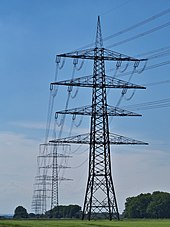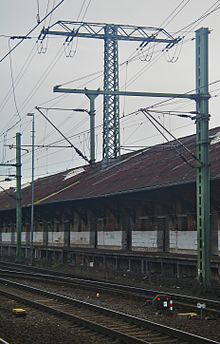Guy mast


A guy mast is a special overhead line mast at which the conductor cables of an overhead line or a section of it end mechanically. Usually the overhead line is continued directly on the other side of the mast with a new section, but it can also be continued on another route, for example via an underground cable.
Construction
In the case of guy masts, the insulators do not hang vertically on the mast as in the case of support masts, but instead align themselves through the mechanical pull in the direction of the conductor.
If the line is continued on the other side of the mast, the current loops , which are usually hanging freely under the insulators, establish the electrical connections between the conductors of both line sections. As a rule, the current loop is formed from the connection of the two free ends of the conductor cables. The simplest design of a twisting mast is made by running two or all power loops crosswise on a guy mast.
Since guy masts not only bear the weight of the conductor cables, but also have to absorb the tensile forces and, when the route changes direction, also shear forces, they are usually more stable than supporting masts .
commitment
Bracing masts are usually used as corner masts where the route of the overhead line changes. In principle, this is also possible without a guy mast by using an angled support mast , but this is rarely done in Germany.
The last mast before the introduction of an overhead line into a switchgear is almost always a guy mast, which absorbs the high tensile forces of the line, followed by a guy portal . Another arrangement is often found in Great Britain , where the last guy mast is at normal height within the switchgear and at the same time takes over the function of the portal, in that the conductor cables are guided vertically from the mast to the area of the system close to the ground.
The same applies to the transition to an underground cable , here the terminal mast is also a guy mast. Branch masts are mostly also guy masts for at least the line that continues in another direction.
Guy masts are often found - especially on older lines, such as the German north-south line - on both sides of the crossing of a railway line, a river or a valley. In addition to their higher resilience, they offer higher ground clearance for the conductor cables with the same overall height, as these are attached to the mast at approximately the level of the crossbeam and not at the lower end of an insulator hanging on the crossbeam.
Since conductor cables for overhead lines cannot be manufactured longer than about five kilometers in one piece, a transition from one line section to the next must be created with a guy mast after this line length at the latest, even if the route is straight.
particularities
- The guy mast in the reservoir of Santa Maria in Switzerland stands on a foundation in a reservoir .
- The most numerous series of guy masts in Germany are in the railway power line of the high-speed line Hanover – Würzburg (Rethen – Gemünden) in the urban area of Fulda . Because of the severely restricted route space, 30 guy masts follow one another, sometimes at very short intervals. The northernmost is mast 9124 , the southernmost mast 9095 . One of them, Mast 9108 , stands in a storage shed at the Fulda train station and pierces its roof.
Web links
literature
- Reinhard Fischer, Friedrich Kießling: Overhead lines: planning, calculation, execution . 4th edition. Springer, 1993, ISBN 978-3-642-97924-8 .


